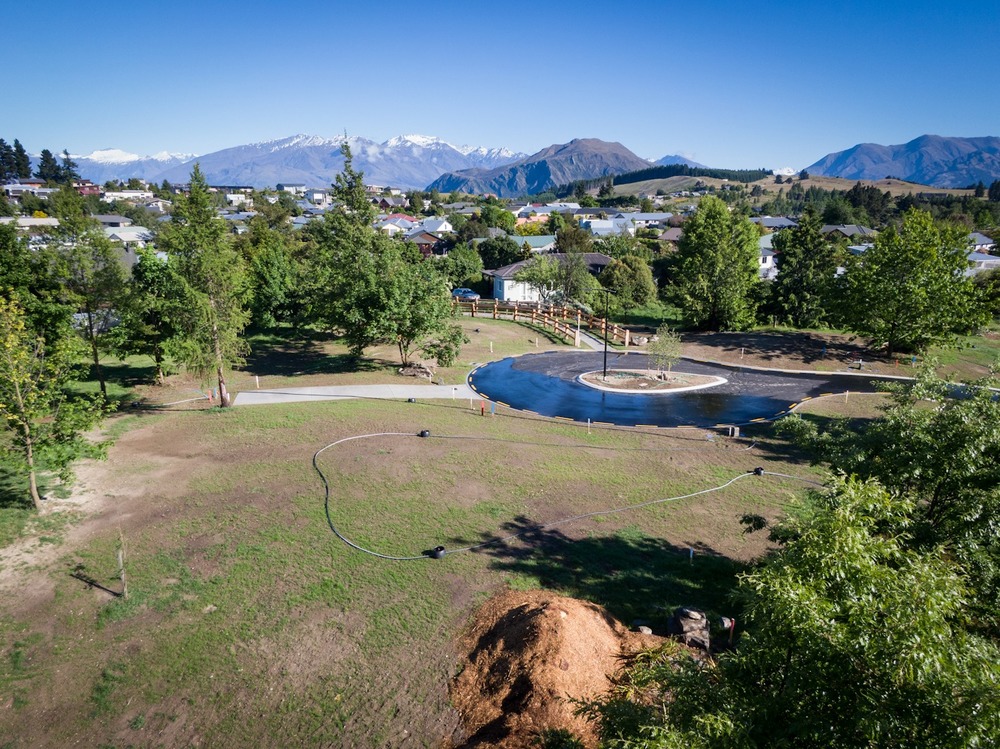Development with a difference
Maddy Harker
27 January 2021, 5:06 PM
 Bellbird Developments developer Vicki Spearing at Greenwood Lane (4 min).
Bellbird Developments developer Vicki Spearing at Greenwood Lane (4 min).Wanaka’s most recently completed subdivision, Greenwood Lane, is more than the sum of its parts: Vicki Spearing, from Bellbird Developments, hopes it will inspire conversations about building and developing more sustainably.
Greenwood Lane is a small-scale subdivision in the Mt Iron area with six sizable sections. It sits on an elevated, sunny site, with established trees, and a public walkway newly planted with feijoas nearby, running through it.
Unlike most developers, Vicki isn’t as excited about selling the sections (which are “basically all sold”) as she is about the vision she has for its future and the incentives she has created to encourage buyers to build energy efficient homes.
“My vision is that every house built here is an energy efficient home, I want it to be a talking point that generates conversation and shows it can be done”.
She envisages a closely connected community that knows and looks out for each other, and wants more developers to consider the “liveability” - everything from keeping trees for shade and amenity, to creating spaces for people to connect with each other - of their developments.
Vicky believes we can do more to build resilience into communities through greener infrastructure and more regenerative planting, but said this involves legislative change as there are still barriers to innovation.

Greenwood Lane.
At Greenwood Lane, Bellbird Developments rewards owners who build homes beyond the New Zealand Building Code with up to $20,000 in cash back incentives - $10,000 for those who meet certain criteria above the building code and $20,000 for those who build to a certifiable International Passive House Institute standard.
There’s also up to $5,000 available for the cost of energy modelling and certifying the performance of homes built in the subdivision. Other measures, like covenants preventing the use of gas, diesel or petrol for heating, encourage owners to live in a more energy efficient way.
Vicki said the cashback incentives are “a way to inspire conversations about how we can build better.” She said it’s “hugely important” to build for the future, as we lock in emissions for the life of the building when we build.
There can be higher upfront costs when you build passive or energy efficient homes but the ongoing heating and cooling cost reductions can save money in the long run. “A passive house uses 95 per cent less energy – that’s 95 per cent of your power bill wiped out,” Vicki said .“That is a significantly lower carbon footprint. If people have a set budget, another option is to build a slightly smaller home.”
Houses create carbon in two ways, she said. “There’s the embodied carbon during the building process and carbon created within the house.”
A recent report by the NZ Green Building Council, A Zero Carbon Roadmap for Aotearoa’s Buildings, shows the environmental harm that comes from New Zealand building, many of which are built only to building code regulation.
“The built environment is culpable for approximately 20% of our country’s carbon footprint. And constructing and renovating New Zealand buildings pumps out climate-changing pollution equivalent to the emissions from one million cars on the road every year.”
“...our buildings are responsible for significant climate-changing pollution. Emissions from the construction sector have leapt 66% in a decade,” the report said.
The International Energy Agency stated in its review of New Zealand’s energy policy, “The New Zealand Building Code is below the standards required in most IEA countries with comparable climates.”
And the Ministry of Business, Innovation and Employment report, Building for Climate Change, published last year, pointed out that London and Christchurch have similar heating degree days (number and severity of cold days) but in England regulation requires insulation levels and air tightness at least double and, in the case of floor insulation, five times that in New Zealand.
Why are New Zealand standards so low compared to other, comparable countries, and why aren’t more people choosing to build energy efficient or passive homes?
“I think the real issue is a lack of awareness about energy efficient building, and that it can be difficult to find good information about building better. People are not yet demanding better because we don’t know how bad it really is. Once people realise what they can have, the decision is easy. We should not accept thousand dollar power bills or condensation on windows as normal.”
There’s also pressure in the building industry to complete jobs within tight frames and budgets, which doesn’t encourage innovation, and Vicki says Kiwis’ laid back mentalities may play a role too: “There’s a level of acceptance: An attitude of ‘We will just make do’.”
Despite the challenges, Vicki feels strongly that change is coming, and fast, especially in Wanaka.
“While driving change is difficult, there are lots of people in council who are on board with these ideas,” Vicki said, pointing to the Luggate Hall build, which will be council’s first passive certified building.
“In Wanaka we have a really proactive group of people.. We are a very conscious minded community, we have more energy modellers and certified passive house consultants in the Southern Lakes Region than other places in New Zealand.”
Vicki is happy to talk to anyone wanting to learn more about building more sustainably, and connecting them with others. (The resources section on her website is a good starting point for people wanting to learn more).
At the national level too, “there is change in the pipeline”, Vicki said. “The building code is being reviewed. There’s going to be pressure at a national level and people need to school up.”
Vicki, a former real estate agent, came into the Greenwood Lane project in a roundabout way.
Volunteer work with One New Zealand for its One Sustainable Summit over the past three years opened her eyes to the role buildings play in carbon emissions and their impact on the environment.
Around the same time, Vicki joined a community-minded group called Thrive, which considered how housing can shape a thriving community. Then in late 2019 the Greenwood Lane site came up for tender, and the members of Thrive decided to imagine it as an ‘exercise’ in how that site could be developed.
“We imagined shared gardens, solar capture with a microgrid system, food forests, spaces to connect and interact - resilience in all forms, and decided: ‘Actually, why don’t we make this happen?’”
Thrive tendered and got the contract, but the feasibility study that came next showed that the group couldn’t make their vision work financially. That seemed like the end of it, until Vicki heard what back up buyers were considering doing with the park-like site.
“It was zoned for 11 sites and I had heard there could be 21 units on it. The site would be wiped clean, all the trees bowled. I thought surely we could do something more sympathetic even if it wasn’t the ideal we had dreamed of.’”
Vicki decided to buy the block and if she couldn’t pull it together, she would then on-sell the block to one of the underbidders knowing she had at least tried. The problem: she finalised on March 21, four days before the national COVID-19 lockdown.
With unfortunate timing, there were no other buyers interested in the property and Vicki decided: “I have to push ‘go’. I launched straight into a previously approved plan for six lots, saved some trees and made the best of it.”
Buyers have got on board with the vision: One, who is planning a passive build, says he will make his home open to visitors who want to learn about building passive homes. Another, a fanatical gardener, has big plans for gardens and wants to share his produce and knowledge with the neighbourhood.
While Greenwood Lane might not look the same as Thrive had initially imagined, Vicki said the project had been both challenging and rewarding, and a vehicle for sharing information about energy efficient building.
“There are things I would have done differently in an ideal world, but I’m proud of what has been achieved”.





